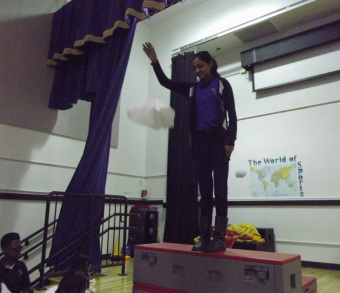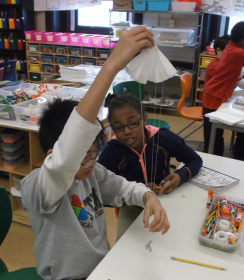
Learning experimental design, 5th graders are calculating averages over three trials and drawing conclusions from their results. It took a lot of teamwork to complete their first set of experiments. Way to go 5th graders!
Aerospace engineering is one of the most fascinating branches of engineering. Aerospace engineers focus on the development of technologies that fly both above and below the earth's atmosphere. This means they must know the design, construction, and the science behind the forces and physical properties of rockets, parachutes, aircraft and other spacecraft like satellites. How exciting!
 Now that 5th graders were able to control wind speed and direction by eliminating them altogether, they've completed their first parachute experiment focusing on how the size of a parachute's canopy affects the rate at which it falls. Learning experimental design, 5th graders are calculating averages over three trials and drawing conclusions from their results. It took a lot of teamwork to complete their first set of experiments. Way to go 5th graders! Over the course of the next two weeks, we'll be testing our parachute designs. We're investigating these three questions:
1. How does the size of a parachute's canopy affect the rate at which it falls? 2. How does the material a parachute's canopy is made of affect the rate at which it falls? 3. How does the length of a parachute's suspension lines affect the rate at which it falls? Fifth graders have identified the variable they are testing in each experiment and the variables they'll need to control to make them fair tests. The variable we test is the ONLY factor that is changed in an experiment. For example, in the first question, the variable being tested is the size of the parachute. The variables we control are the factors that are kept the same. Again, for the first experiment, the variables controlled are the material of the canopy, the length of the suspension lines, the weight of the load, and the drop height. The first set of fifth graders went outside to test their parachutes, and unfortunately, it was a flop! The wind was too intense, and the air conditioning units on the 3rd floor below got in the way, affecting our landing times. Next week we'll be discussing how we can make our tests more fair, as the results we got were extremely inconsistent.  Since fifth graders have finished their spacecraft designs, their next focus will be on meeting the need to safely land the spacecraft. Parachutes are an important technology that aerospace engineers develop, and while it's obvious that they can slow down a spacecraft, many variables can affect its descent. Using science in engineering, fifth graders are building, testing, and drawing conclusions from controlled experiments to figure out how the design of a parachute affects the rate at which it falls. Does a bigger canopy always fall slower? Or does it depend upon the material from which it is made? Does the suspension line length make a difference in its fall time? We'll be exploring these questions! Each team of fifth graders completed their spacecraft design, suited for a specific planet! Because engineers must communicate with others, fifth grade engineers shared their designs with other teams of engineers. Fifth graders gave feedback to one another. Great work fifth grade!
|
Mrs. BrinzaWhat part of space history is most interesting to you? Archives
May 2014
Useful Links
|